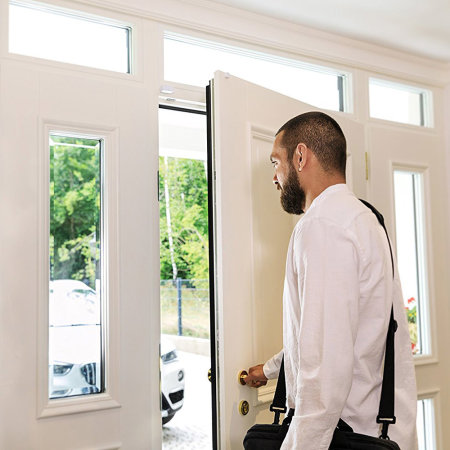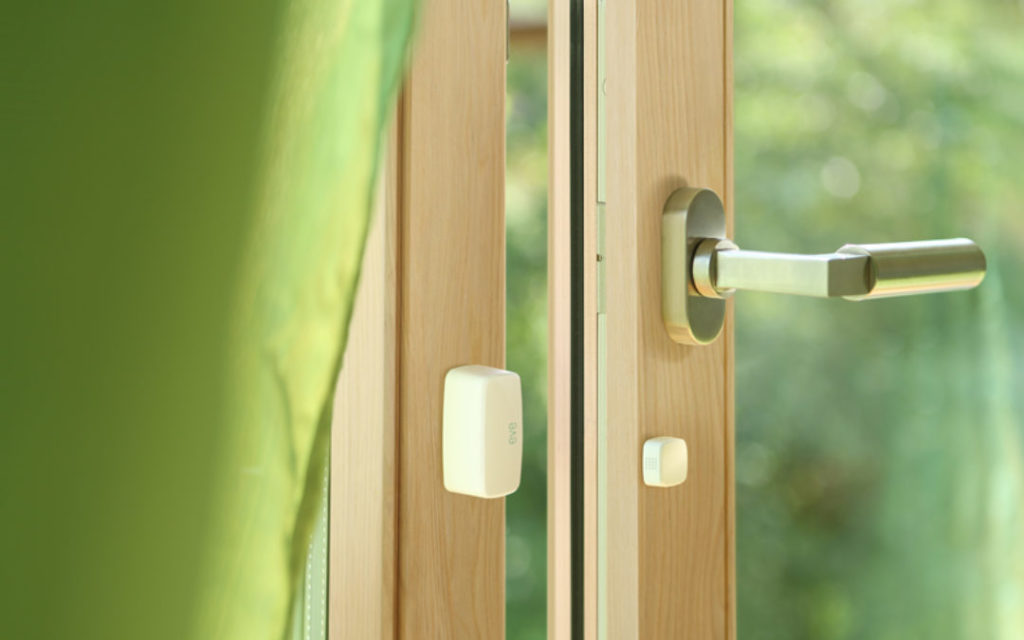I don’t know about you, but I have fond memories of being a child fascinated by the light in the refrigerator wondering if it always stayed on thinking: “Surely, it couldn’t. My yogurt doesn’t need light.” After hours of investigative experiments attempting to determine if and when the light switched off, the mystery is eventually revealed once we discovered that there is a small rocker switch just inside the cavity of the refrigerator that is activated by the opening and closing of the door (Sorry if I ruined this for you.) Contact sensors perform essentially the same task except they employ magnets and send a digital signal that indicates an open or closed state. The Eve Door & Window is such a contact sensor and despite its name, has a infinite number of uses aside from determining the open or closed state of doors and windows. Let’s look at some of its features, drawbacks, and try to help you decide if this is the contact sensor for you.
Features
- Know the open or closed state of whatever it is you have the sensor connected to from anywhere via app or Siri (Home hub) required)
- exportable statistics on frequency of changes in sensor state over time via the Eve for HomeKit app
- open/closed state notifications via Apple’s Home app (Home hub required)
- automation control of other HomeKit compatible accessories

Need to Knows
- connect via Bluetooth Low Energy
- requires 1 x 1/2 AA (ER14250) lithium battery
- Over 1 year battery lifetime
Pros
I’ve gone on about this in other reviews of Eve’s first wave of HomeKit products, but they really do have a classy aesthetic, particularly the Door & Window. It mounts inconspicuously in most applications and takes a bit part in your connected home. Admittedly since the frames of my doors and windows are brown and black contact sensors tend to stick out a bit more, but I have used the Eve Door and Window with off-white frames and doors and hardly ever noticed it.
There are a few different contact sensors to choose from in the HomeKit ecosystem, but Eve’s offering is the only one, that we’re aware of at least, that accounts for the two surfaces that you might attach the accessory to potentially being uneven by including a few different interlocking plastic spacers that attach to the smaller part of the sensor. This is a very thoughtful design aspect and can help not only with uneven surfaces, but also can reduce interference from steel doors or frames if this is your case.
Despite being a Bluetooth device, the connection to HomeKit is rock solid. Unlike some WiFi accessories that can be affected by router resets, power outages, etc., I’ve not once had an issue with any of my Eve products in terms of it staying connected and this is after more than two years of use. Of course, batteries need to be changed from time to time, but this is easily accomplished and takes only a few seconds. You can check out our video on how to reset Eve Door and Window and access the battery compartment here:
Cons

Bluetooth Low Energy is HomeKit’s preferred connection protocol for sensors. The fact that BLE requires relatively little power makes it ideal for wireless sensors. It’s also independent of an internet connection so you can rest assured that you’ll be notified of undesirable, or desirable, sensor states in the event of a power outage, (as long as you still have juice on your phone or tablet). The downside to BLE is that its range is relatively limited and can be greatly affected by building materials. So having multiple Apple Home hubs throughout your home will ensure that your automations and notifications have the optimum environment in order to function properly. Speaking of Home hubs…
Basically to get more than just the ability to see sensor state when at home and in range of the sensor, you need to have one of Apple’s Home hubs. Automations won’t work unless you have a Home hub. Remote access won’t work unless you have a Home hub. Notifications won’t work unless you have a Home hub. Though Home hubs (HomePod, Apple TV, or iPad) can be a bit pricey, they can be used for more than just HomeKit connectivity and it’s likely that if you are reading this blog, you already have one. So there’s that.
Above we mentioned that the expected battery life is more than a year and since we’ve had this accessory for more than two years, I can attest to this. In fact, I got about a year and a half out of the included battery and changing the battery is a breeze. The drawback is the type of battery, 1/2 AA. In fact, until I met Eve Door and Window, I’m not sure I had ever even known of this battery type. Though it can be a little difficult to track down, you can find it pretty easily online or at camera or photography shops.
The App

I’ve waxed poetic about the Eve for HomeKit app since the inception of myHomeKithome and continue to praise its ability to create pretty powerful HomeKit scenes and automations often offering features that are built into the HomeKit framework, but not available as of yet in Apple’s Home app. Eve does very well with providing additional features for its own products as well mostly in the realm of data from its accessories.
For the Door & Window, the app offers a robust graph-based visual timeline of detected open and closed states with time stamps and a pretty lengthy history. We are also presented with a frequency counter with an accompanying graph which helps us quickly identify if something is maybe being opened too often, or maybe not enough….I’m looking at you, cookie jar. For those of us who enjoy data and organization, said data can be exported into a number of different apps and subsequently rifled through.
Final Thoughts

Sensors are really where the connected home starts to become a reality. Talking to a speaker and having things happen is convenient, but not all that natural for many of us. I prefer to analyze the behavior of people who use a home, issue commands once, and then have HomeKit and sensors do the “heavy” lifting. Contact sensors in particular not only allow for peace of mind as to whether or not you closed something, but can also act as triggers for automations that, ideally, make our lives easier. After having played around with the other two major contact sensors currently compatible with HomeKit, I have to say Eve Door & Window is the clear winner. The all have basically the same reliable connectivity and accuracy, but where Eve’s creation really shines is in its flexibility in terms of material and uneven surfaces and its feature-rich app. The accessory is also pretty competitively priced, at least for a HomeKit product. Until something more compelling comes along, the Eve Door & Window will be my go-to for my contact sensor needs.
What have your experiences been like with the Eve Door & Window or any other HomeKit contact sensors? What unique ways have you found to use contact sensors? State your case in the comments below. Loads more HomeKit content can be found on Facebook, Twitter, and Instagram @myhomekithome.
Links & Resources
Learn more about Eve range of HomeKit-compatible smart home gear at https://www.evehome.com
We use income-earning affiliate links.
We may receive a small commission on purchases made using links on this page at no extra cost to you.

